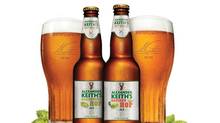In yesterday’s Globe and Mail, there was a puff piece extolling the latest in the corporate brewers’ manoeuvrings (read the article here). Labatt (AB-Inbev), makers of the Alexander Keith’s line of faux-craft beer, this spring is launching two new Keith’s beer – Hallertauer Hop Ale and Cascade Hop Ale. Both are single-hopped beer, and Labatt indicates other varieties may follow.
Apparently the big boys are hopping on the single-hop bandwagon (sorry!). But those expecting a hoppy, IPA-like flavour from these beer should temper those hopes. The Labatt spokesperson (the only person interviewed in the article) says that consumers don’t really like the taste of hops. As the reporter paraphrases:
Many people claimed to prefer hoppy beers [sic], but in blind taste tests most chose lighter-tasting brews. So Labatt will be marketing the image of hops in advertising Keith’s new single-hop ales, but the flavour is more subtle than an intense craft brew might be.
The beer is not yet in a single store (full national release coming in April), and so it would be premature to judge the flavour of the beer itself. I will await their release before reaching any conclusions about whether the character of Hallertauer and Cascade hops come through. Instead, I wish to comment briefly on the significance of this step.
In short, hops has come of age. There is no need for me to repeat my longstanding thesis that as craft beer becomes more entrenched and popular, the corporate brewers will engage in a variety of strategies to wedge themselves into that market, including buying craft breweries, launching new brands that emulate craft, and shifting marketing language to appeal to craft drinkers. This is an example of the second and third tactics.
This is latest in a line of releases attempting to provide beer that at least looks like craft beer. From Rickard’s Dark (which isn’t half bad), to the various “white beer” now available, to their respective “seasonal” releases, the corporate brewers are actively trying to mix into the flavourful end of the beer market.
It would be very easy of me to look at this latest development cynically. They are openly admitting that they are using hops as a marketing ploy, rather than a feature of the beer itself. This is what happens when you design beer by focus group. But I will refrain from putting on my old curmudgeon hat for the moment. In part because I haven’t tasted the beer yet (and I will report back once I do), and secondly because I see this as the latest admission by the corporate brewers that they are on the wrong side of the market.
Everyone knows that most beer drinkers prefer lighter, sweeter beer. Hops is, in many respects, the last frontier in beer exploration. The pungent bitterness takes getting used to. What this announcement by Labatt tells me is that consumers intentions are heading in the right direction. They know hops are important and that hops helps make beer more flavourful. Their taste buds have not quite yet caught up with their intention, but they will. When Labatt releases something – even just in marketing – that accents hops, you know that the c0nsumer has turned an important corner around beer appreciation. At least that is how I choose to interpret this move.
In a way I tip my hat to Labatt for getting on this so quickly. Single-hop brewing has only recently caught on among craft brewers. That the suits at Labatt saw both its importance and potential so quickly is a testiment to their acumen. And, possibly, an indication of how quickly the beer market is shifting.
As an aside, I must proclaim my annoyance at the Globe piece. It was obviously spoon-fed to the reporter. It has an unquestioned positive spin, the only person quoted is Labatt’s VP of Marketing, and it even has a graphic image that is not yet publicly available (and thus supplied by Mr. VP’s staffers). Such is the challenge with business sections – so much of it is fed by PR reps, and little real reporting is included. Irrelevant to this blog, but I mention it any way in the interests of media literacy.
A final bit of news from the article: Goose Island, the American craft brewery recently purchased by AB-Inbev (see strategy #1 above), will soon be coming to the Canadian market. That sounds like a good thing to me.



March 7, 2013 at 7:05 PM
Just a quck note: The Cascade single-hop is actually available in the province right now. I ordered a case that will be coming in to our store tomorrow (March 8th). The Hallertauer and a mix pack were still unavailable but will probably be here soon (maybe next week?). I must say, I am curious to see how this all goes over..
March 7, 2013 at 7:43 PM
Thanks, Stephen. I couldn’t find any source that indicated the beer had arrived yet. Sounds like they are here, or will be very soon. I guess that means we will know soon what they are about.
March 8, 2013 at 1:19 PM
Goose Island was actually bought out by ABInbev coming up on two years ago now. As for the beer itself I’m really looking forward to it’s arrival. The last time I was in Chicago, before they were bought out, I had the privilage of going on a tour while I was there on a Master Brewers Association course. All of the beer I had from them was great. It will be nice to see what they start with in Canada. My guess 312.
March 9, 2013 at 10:06 AM
Wow, deep stuff from Labatt. A simulacra beer that Jean Baudrillard would be proud of. Marketing the image of a hoppy beer rather than an actual hoppy beer. The faux over the real. Genius!
March 9, 2013 at 4:29 PM
I really don’t care what type of beer any brewery puts out. But this entire piece continues to prove that companies like AB-Inbev think their customers are complete idiots, and really just want to be sold an image of being cool – whether it is the image of chillaxin’ in a hot tub full of babes, or thinking of oneself as a manly rodeo stud or lumberjack. Craft beer is now cool too, so they are more than happy to sell this image to all the image conscious hipsters and metrosexuals.
Style over substance. Yet again. All this proves is that craft beer is cool. Guess that makes us a bunch of cool mofos.